Note: This article of mine was published on the Luminous Landscape photography website in May 2015.
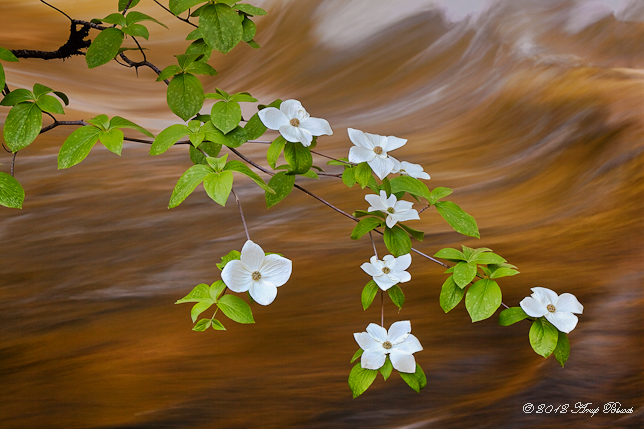
Songs of Silence
Introduction
I am a San Francisco Bay Area-based fine art landscape photographer. I have been photographing landscapes for the last twenty years. Since 2009, I have exhibited my fine art photographs in numerous solo and group exhibitions, including the venerable Center for Photographic Art, originally founded by Ansel Adams and at the Sunset Cultural Center in Carmel Valley, California. Since 2009, my fine art photographic prints have been widely collected.
Motivation
For many years, I have been a frequent reader of the Luminous Landscape website and benefited from its articles in numerous ways. I think it is my turn to give something back to the photographic community. With the advent of digital technologies, these days it is rather easy to capture a technically good photograph. There are numerous books and articles available on this subject. However, creating a photograph that is also a fine work of art is truly difficult. It has very much to do with one’s “vision.” However, when I look back at my last twenty years of photographic career, I see there are a few emerging themes that repeat itself in all of my favorite pieces of work. This article is an attempt to communicate these themes. A picture is worth a thousand words. Whenever possible, I have illustrated my theme with an accompanying photograph of mine.
1. Capture emotion, not landscape
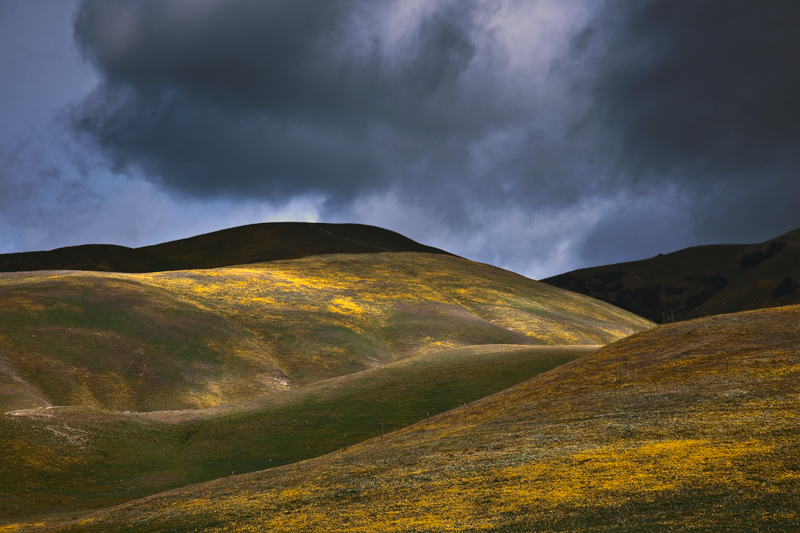
Cloud Melody, 2010, Gorman Hills, California
When I started photographing landscapes, I would go to dozens of gorgeous places and shoot the landscape from the most appealing angle. When lucky, I would get a very attractive photograph. But it would not carry any personal statement. I would just act like a composition machine, applying all the rules I had learned from various books and magazines. After years of practice, immersion in other great works of art, and many photography workshops with renowned fine art photographers, I slowly transformed. Now, I tend towards capturing emotion rather than documenting a piece of landscape. I believe this trait has made me a better artist and will do the same for you, too.
2. Meditate before clicking the shutter

Dogwoods in Redwoods, Yosemite Valley, 2008
It was a gloomy day in Yosemite. It had just rained a little. The dogwoods were in full bloom. I was wandering about near the Pohono Bridge in Yosemite valley, hoping to capture some good images. At that time, I was using a Toyo 4”x5” view camera. Those of us who still remember the view camera would know that the mere inconvenience of setting up the camera would slow you down. Following the advice of my photography teacher and mentor, Charles Cramer, I used to carry a “viewing frame” to help me compose better. It is a piece of mat board with a rectangular opening of 4:5 aspect ratio. These days I use a Digital SLR camera, but still carry the “viewing frame” everywhere I go. It helps me see the photograph in its finished form on the mat board before I even click the shutter. Now, I was holding my viewing frame at different angles when I suddenly saw this composition. It appeared to me as a symbol of hope among the darkness and despair. Had I not used the “viewing frame” I would have missed this composition in the clutter of the forest.
3. Take many variations of the subject
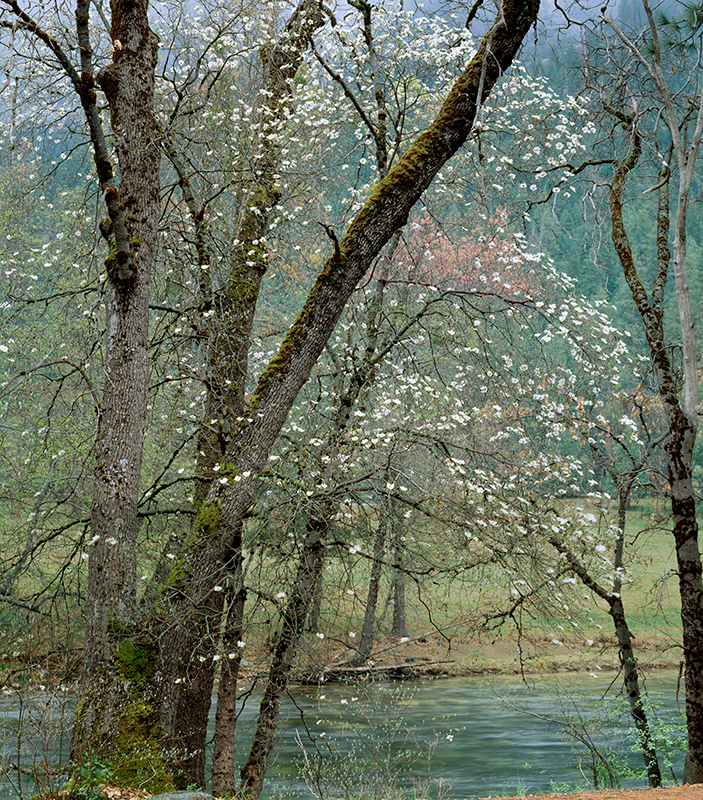
Dogwoods in Fog, 2005, Yosemite Valley
It took me three years to take this photograph. I first photographed this dogwood tree in full bloom in 2003 at Yosemite Valley. The Merced river at the bottom of the frame, green trees in the background, and the blooming dogwoods tree caught my attention. I took several frames from different angles, but was still unhappy with the images. I went back to Yosemite Valley during the same time in 2004 and captured few more frames. Still, something was lacking. Finally, I captured this image in the spring of 2005. It was a foggy day. The hillside was suffused with this soft enveloping light that adds an inner glow to the landscape. I set up my Toyo view camera and looked at the inverted image on the ground glass under the dark focusing cloth. When I looked at this image, I had goose bumps all over my body. I knew this was something special, almost spiritual. Don’t give up until you capture the emotion in the landscape you are looking for.
4. Look for a metaphor
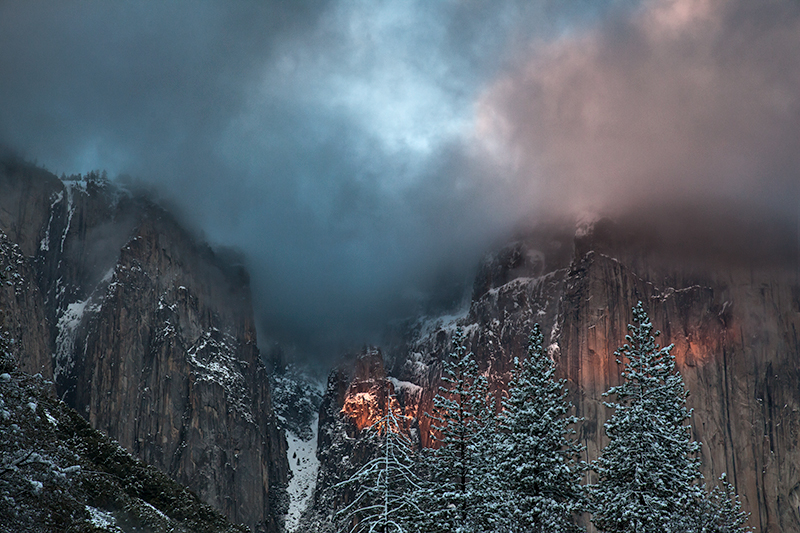
Last Light, Yosemite Valley, 2012
During the winter of 2012, I visited Yosemite Valley when I photographed this scene. What does this photograph mean to you? On the surface, it is a photograph of falling sunset light on a piece of rock. But, be still. Listen to it. You will realize that it has deeper connotations. To me, it symbolizes the last light shining on the earth before the whole planet plunges into darkness. Is it a sign of hope or sign of warning? The meaning depends on you and your world-view. But it is definitely more than a pretty sunset photograph of Yosemite. Always look for symbolism in your photograph that transcends the time and space and reveal an universal truth.
5. Bad light is good light
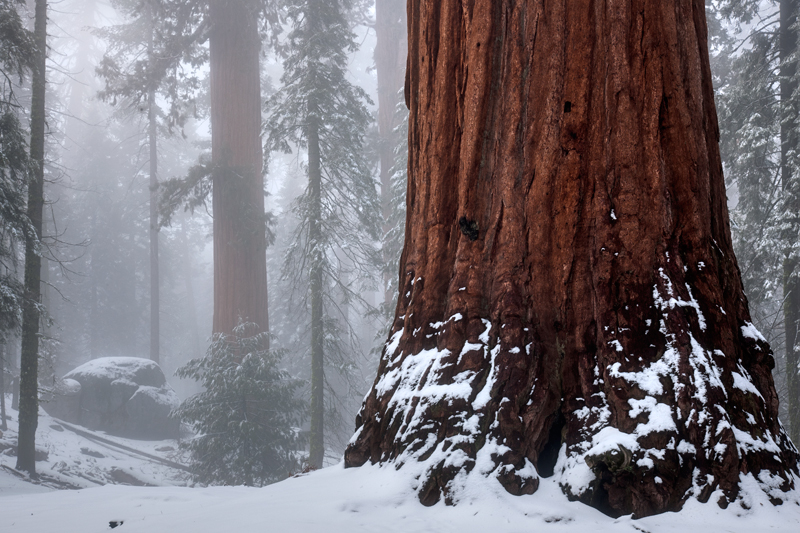
Winter Storm, Kings Canyon, 2012
I photographed this image in Kings Canyon National Park during a snow storm. I was hiking along a trail. Suddenly, it became dark and started snowing. Almost everybody hiking on the trail rushed to the comfort and safety of their car. However, from my years of experience in photographing landscapes, I knew these were the times when exquisite photographs are made. This is when landscapes are most expressive: transcending space and time, they become visual poetry and help us express our innermost feelings.
6. Don’t neglect your neighborhood
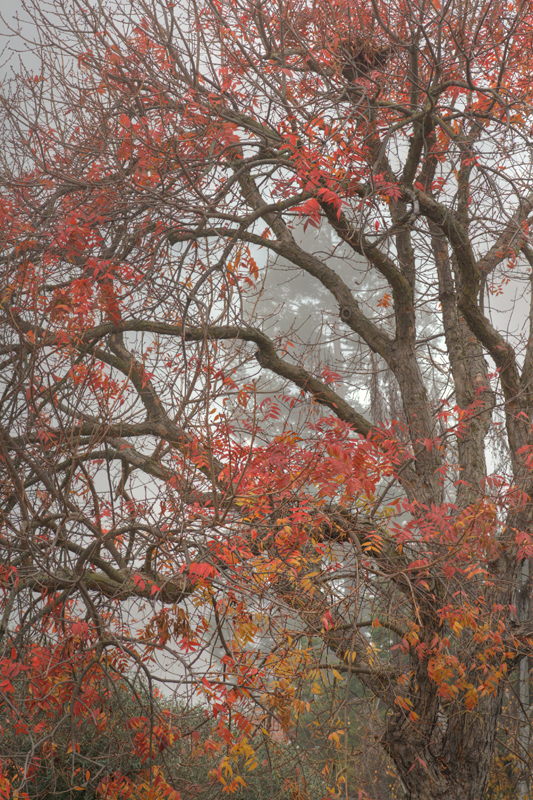
Morning Sonata, Los Gatos, California, 2009
It was a foggy autumn morning. I came to drop my daughter at her elementary school. When I came back to my car, I noticed these colorful trees radiating through the fog. I started walking down the street, looking for the right tree that would express my feelings at that time. When I came across this tree, I knew I found what I have been looking for. Fortunately, I had the camera in my car. I spent the next hour photographing many different compositions of this tree. Sometimes, you don’t have to travel long distances to create expressive photographs. It is there right beside you. You have to just open your eyes and heart.
7. Immerse yourself in great art
One of the most effective ways to improve your fine art photography skill is to look at the work of the masters. I go to libraries to browse the photography section. I regularly visit fine art photography galleries like the Ansel Adams Gallery in Yosemite, and Weston Gallery and Photography West Gallery in Carmel Valley. Over the years, I have built a sizable collection of photography books by Ansel Adams, Edward Weston, Wynn Bullock, Paul Caponigro, Eliot Porter, Imogen Cunnigham, Ernst Haas, Man Ray, Jerry Uelsman, Shinzo Maeda, Christopher Burkett, Joel Meyerowitz, John Sexton, and many others. I have also associated myself with Fine Art Photography organizations like the Center for Photographic Art in Carmel Valley. This immersion in great works of art inspires me, shows me direction, and emboldens me to experiment with new ideas.
8. Expand your horizons

Homeless, 2009, Photographic Montage
After years of photographing classic landscapes, I grew little bored with repeating myself. I was creating expressive photographs. My audience at the gallery was very appreciative of the works I was doing. But I needed to break new grounds. This is when I started experimenting with digital montages. I embarked upon taking a new series of photographs, titled “Strange Tales.” In these photographs, I narrate the story of the environmental destruction of our planet through the eyes of a Penguin. This photograph was selected in the annual juried exhibition at the Center of Photographic Art in 2009. My suggestion to you is this: Do not get trapped in a single line of work. When you mastered a specific style, created a loyal audience of your work, it is time to try something new. I can promise that it will enliven you.
About Arup Biswas
Arup Biswas has been photographing landscapes for the last twenty years. Since 2009, his fine art photographs have been exhibited in numerous solo and group exhibitions, including the venerable Center for Photographic Art juried exhibition and solo exhibition at the famous Sunset Cultural Center, both in Carmel Valley. Arup is represented by the Main Gallery in Redwood City, California. You can find the complete portfolio of Arup’s works at his website www.arupbiswas.com. Arup would like to hear your comments regarding this article or any other topic at arup@arupbiswas.com. Arup holds a Master’s Degree in Computer Science from the Indian Institute of Technology, Kharagpur, India.














